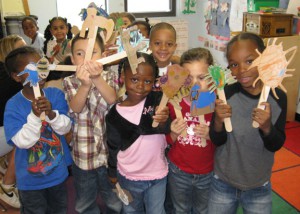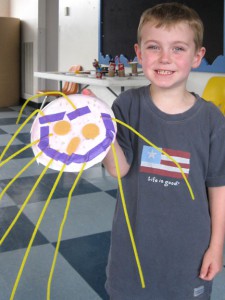By Carly Baumann,
Exhibit and Program Developer, Providence Children’s Museum
I love puppets — whether playing with them myself or watching others bring them to life; they straddle the world of real and pretend. Though Daniel Striped Tiger’s mouth never moved on Mister Rogers’ Neighborhood, which I only noticed as an adult, the puppet’s kind, shy personality was completely true to me.
 Holding a puppet is empowering to a child, intimately controlling its movements, sounds and voices while directing a character, roles and situations. For the young child, puppets become part of imaginative play — following his interests, taking on the character of who is important to her at the moment. Puppets grow with the child. School-age friends enjoy teaming together to create puppet shows and figuring out how to organize, compromise and see a project through from beginning to end.
Holding a puppet is empowering to a child, intimately controlling its movements, sounds and voices while directing a character, roles and situations. For the young child, puppets become part of imaginative play — following his interests, taking on the character of who is important to her at the moment. Puppets grow with the child. School-age friends enjoy teaming together to create puppet shows and figuring out how to organize, compromise and see a project through from beginning to end.
Children develop fine motor skills when manipulating the materials to make a puppet and then to move it in different ways. Constructing simple puppets at home is a fun and creative process of exploring materials and making choices to create a character. What kind of eyes could my monster have? What fabric would make the right skirt for my fairy? How will I get this hair to stay put?
Here are some ideas for making your own puppets:
TALK TO THE HAND
The simple hand-grasping motion of the familiar paper lunch bag puppet is just right for little hands. To make teeth, fold a paper plate and staple or glue it to the puppet’s mouth. Sock puppets are full of fun, especially when they are made to laugh and sing. Decorate a sock-without-a-match with materials and glue, or just slip a clean sock on your hand and tuck the end between fingers and thumb for spontaneous silliness!
STICK IT TO ‘EM
Top a craft stick, skewer or ruler with a character to make a stick puppet that’s ready for action. To turn it into a pop-up puppet, poke a hole in the bottom of a paper cup and slide the stick through to make the puppet “hide” in the cup. Slide the stick up and down to bob the puppet above the cup’s rim to peek-a-boo.
LET YOUR FINGERS DO THE WALKING
Fingers become bodies when they slip into glove finger puppets, but they can also make perfectly jointed legs. One idea is to cut two finger holes toward the bottom of an index card, draw a body onto the top and let the fingers dance and bring the puppet to life.
Our favorite materials for embellishing puppets:
- Felt and fabric scraps
- Bits of cardboard, construction paper, tissue paper, old paintings cut into pieces
- Supplies for attaching materials: twist ties, pipe cleaners, wire, tape, rubber bands
- Reusable junk: caps, packing peanuts, buttons, cardboard tubes, straws, curling ribbon and yarn
For more puppet fun, join Puppet Play programs at the Museum on October 9, 10 and 11 — check the calendar for details. Also take a peek at I Live in a Small Town, the Museum’s playful new finger puppet display by local artist Megan Jeffery.










Hi S,
Let’s talk!
Carly
(401) 273-5437×137
Carly, do you do puppet making workshops? I’m looking for someone to do one with my adult graduate students at RIC.